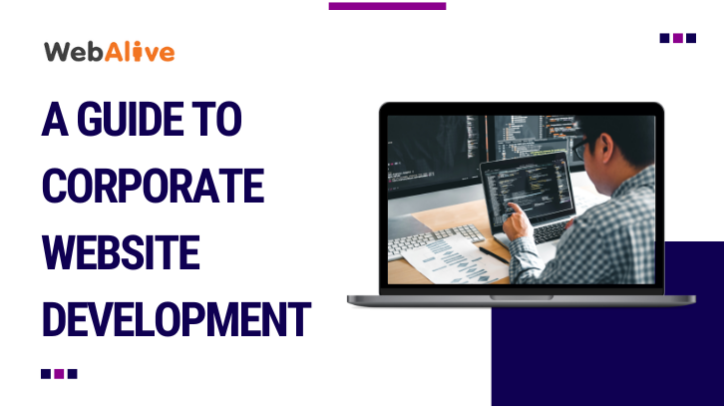
What Is Corporate Website Development (And How to Build One)
For any company, when it is about taking a prominent place in the competitive landscape, there is no second thought on the necessity of a corporate website. Even though several opinions exist, with reasons varying based on individual perspectives, the statement couldn’t be any truer.
Now, you might be thinking about what could be the difference between a corporate website and an individual website. Although both are created to attract an audience through the information they host, the difference is very much apparent from the landing page. A corporate website tends to have a more professional-sounding tone and frequent updates than individual websites.
As the process of corporate website development is way different than launching a personal blog, creating a website can pose challenges and expenses if the corporate web development process isn’t well understood, with requirements and goals clearly defined.
So, here we will discuss how to master the process of making the digital face for your business.
What is a corporate website?
Professional in design, corporate websites serve as dedicated online platforms for companies to showcase and promote their products or services effectively.
A website is a must-have for any corporation. A standard corporate website goes beyond being a mere online presence; it rather functions as a hub for establishing brand identity, presenting the key details: company profile, operations, staff, events, and client-centric content like testimonials, partners, stakeholders, and case studies. The corporate website plays a key role in customer engagement, feedback collection, and delivering enhanced customer support.
The main objective is to enhance the reputation, provide support, and work on the mission and values of the entire. Entity- be it a company, brand, educational institution, or non-profit organisation- prioritising these over the specific services or products it provides.
Basic phases to craft an outstanding corporate website
Your website serves as the gateway to millions of prospects, all of whom have the potential to become customers and partners. When building a corporate website, you must have to be familiar with the best practices and strategies.
1. First and foremost, define your requirements and objectives
Before embarking on the development journey, it’s crucial to have a clear understanding of what you want to achieve with your online presence. Defining the requirements and goals of your corporate website involves considering the following key elements:
- Identify your company’s core values.
- Clearly define the specific need(s) your business addresses.
- Highlight the uniqueness of your service or product.
- Clearly understand your target market.
- Determine the necessary functionalities and technologies to achieve your business.
So, try to identify and clarify the specific goals and purposes that your website will serve, like whether you are looking to showcase products, generate leads or facilitate online transactions. For example, if lead generation is your key objective, you need to optimise your site strategically by placing contact forms and compelling calls-to-action while offering downloadable resources in exchange for contact details.
Also, determine your target audience and customise your website to cater to their needs. Consider demographics, preferences, and behaviours to craft a user-centric design that connects with your audience.
2. Pick the right technologies
Selecting the appropriate technologies is a significant element in corporate web development, as it significantly impacts the website’s functionality, performance, and maintainability.
Content Management System: Choose a CMS with an intuitive interface that will enable you to create, manage, and modify digital content without requiring advanced technical skills. Look for a CMS that offers flexibility for customisation to meet specific business needs.
Web development frameworks: Frameworks will provide a structured and pre-defined set of tools, libraries, and best practices to speed up the development process and enhance code maintainability. So, pick a framework that allows for scalability as your website grows and aligns with your team’s expertise.
Security Measures: Security is paramount in corporate web development to protect sensitive data, user information, and the overall integrity of the website. Implement SSL certificate, conduct regular security audits to address any vulnerabilities and try to keep all software, including CMS, frameworks and plugins, up-to-date.
3. Go for a professional website design
Creating a corporate website involves combining strategy and creativity to build an online presence that mirrors a company’s brand, goals, and what users expect. This process includes blending visual elements, focusing on user experience (UX), and ensuring the site functions smoothly.
Once you clearly outline the purpose of your website, seek inspiration from websites beyond your industry to pinpoint design elements that align with your objectives. Then, outline the structure by defining primary categories and subcategories. Establish a logical flow to enable users to navigate effortlessly.
Create prototypes to visualise the user interface (UI) and collect feedback in the early stages of the design process. Focus on branding and visual identity using consistent colour schemes, typography, and logos because a visually appealing website adds trust and strengthens brand recognition.
Boost user satisfaction and promote engagement by prioritising a user-friendly and intuitive interface with easy navigation on your well-designed website. Consider the mobile experience as an integral aspect of the design process.
4. Development and implementation
This phase involves translating the conceptualised ideas into a functional and interactive digital platform. From coding and programming to database development, it requires everything. Create a scalable structure that can handle future growth. Consider possible increases in traffic, content, and features to avoid major changes as your business grows.
Allow the web designer and developer to pick the right tools and languages, like frameworks and libraries, to build the core of the corporate website. The goal is to ensure the website meets the business goals, requirements, and expectations.
Also, work on content development. This involves writing text for different website parts like headings, subheadings, tags, blocks, and links. The content should be interesting to grab the attention of website visitors.
5. Run tests to ensure optimal performance
Testing and quality assurance are key components of the software development lifecycle. Your website should undergo rigorous testing to ensure that the developed software meets specified requirements, functions as intended, and delivers a positive user experience. Otherwise, several issues, like misspellings, broken links, and unresponsive layouts, can hurt the business if not carefully addressed before launching.
You should conduct performance testing to optimise loading times and test cross-browser compatibility by testing your website across browsers and devices to ensure a consistent experience for all users. Involve end-users in the testing phase to collect valuable feedback and address user concerns and preferences, improving overall user experience.
6. Launch your site and create a maintenance plan
While launching a corporate website marks a noteworthy milestone, remember the journey doesn’t conclude with deployment. Post-launch activities play a vital role in guaranteeing the website’s sustained success, performance, and relevance over time.
After the website goes live, regularly monitor the website for performance issues, security vulnerabilities, and downtime. Implement a maintenance schedule to address updates, patches, and improvements. For example, to maintain the website’s content freshness, adding posts, updating images, and removing unnecessary widgets are necessary.
Routine updates, backup procedures or source code maintenance should be performed on a daily, weekly, or monthly basis, as required.
Conclusion
So, creating a successful corporate website involves going through these mentioned phases. Each phase has tasks that must be completed to move on to the next one. These steps contribute to the overall process of building an expertly crafted website that not only enhances the visibility of your site but also instils confidence among your visitors, seamlessly transforming them into devoted customers.
You read a lot. We like that
Want to take your online business to the next level? Get the tips and insights that matter.

